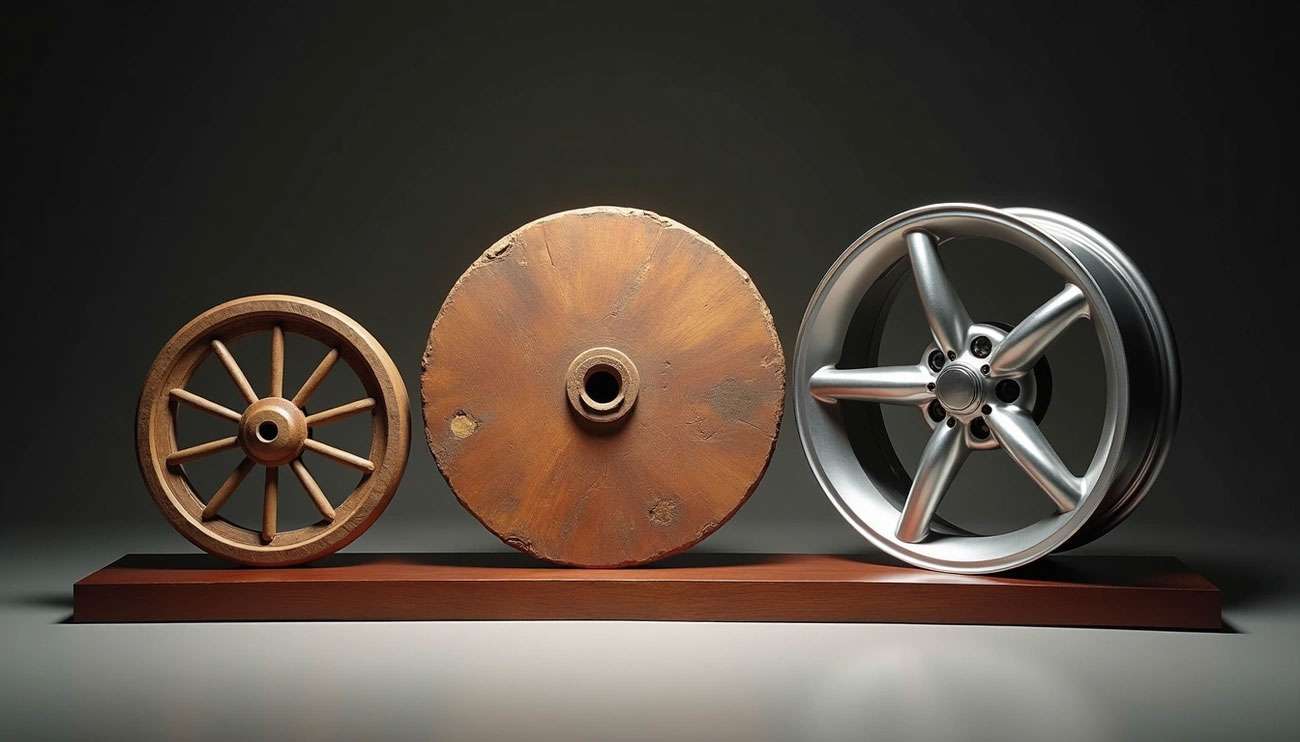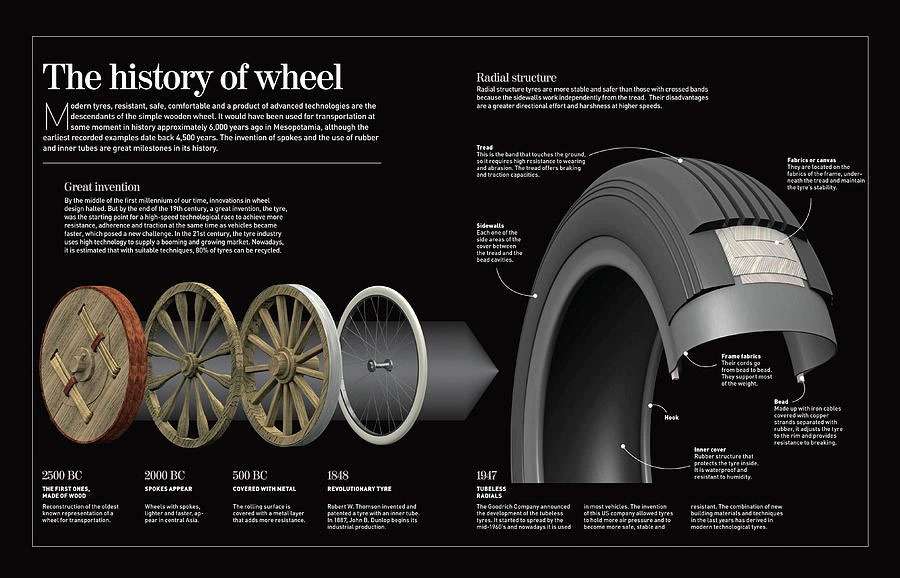
Wheels rank among humanity's most important inventions, first appearing around 3500 BCE in ancient Mesopotamia [5] [4]. The first wheels weren't designed for transportation—potters created them to shape clay vessels before anyone considered using them for moving objects [5]. This simple mechanical device altered the course of human development.
Most people don't think about wheels today, but their creation marked a crucial point in human progress. Solid wooden wheels first appeared during the late Neolithic period (4500-3300 BCE), coinciding with technological advances that brought the early Bronze Age [4]. The oldest wooden wheel discovered dates back to approximately 3130 BCE during the Copper Age [4]. Early wheels were basic wooden disks with holes cut for axles [4], but the development of spoked wheels around 2000 BCE made it possible to build lighter, faster vehicles [4] [1]. Ancient Sumerian pictographs show wheeled sledges [1], and the modern pneumatic tire appeared in 1888 [5]. This progression demonstrates humanity's continuous effort to improve this essential technology.
"But who invented it? This is where opinions differ. Northwest Europe, the Alps region, Southeast Europe and the Middle East are contenders, but all are currently in with an equal chance." — Swiss National Museum Editorial Team, Editors at the Swiss National Museum, experts in historical artifacts

Image Source: History Cooperative
Archaeological evidence shows humans first realized round objects rolled easier than irregular shapes during the Paleolithic era (15,000 to 750,000 years ago) [1]. The earliest wheeled technology appeared as potter's wheels in Mesopotamia around 4000 BCE [2]. These basic rotating devices, called "turntables" or "tournettes," were flat disks mounted on an axis [3].
Recent discoveries challenge established timelines. A potter's wheel found in western Ukraine dates to the middle of the 5th millennium BCE, predating Mesopotamian examples [4]. Research suggests ancient copper miners in the Carpathian Mountains may have created the first wheeled devices specifically for transporting ore [5].
The transition from pottery tool to transportation happened gradually. Clay tablet pictographs from Uruk (Sumeria) show wheeled wagons from approximately 3500-3350 BCE [4]. The oldest preserved wooden wheel was discovered in Ljubljana, Slovenia, dating back to about 3200 BCE [1].
Wheeled vehicles spread quickly across Europe and Asia. The Bronocice pot from Poland (3635-3370 BCE) contains what may be the earliest known depiction of a four-wheeled vehicle [17]. Archaeological evidence suggests the wheel may have been independently invented in China around 2800 BCE [17].
The development of spoked wheels around 2000 BCE marked a major advancement. These designs allowed for lighter, faster vehicles that proved especially valuable for war chariots [1].

Image Source: Britannica
The wheel operates on a simple mechanical principle that converts rotational motion into forward movement. The wheel and axle work as a basic simple machine where mechanical advantage depends on the ratio between the wheel's radius and the axle's radius [7]. Larger wheels create greater mechanical advantage, which multiplies the force you can apply.
Wheel bearings are essential for smooth rotation with minimal friction. You'll find two main types: ball bearings and roller bearings [8]. Ball bearings have small contact points that reduce rolling resistance, making them perfect for speed applications. Roller bearings offer larger contact surfaces, which makes them better for carrying heavy loads [9].
Wheels work so well because they dramatically reduce friction. Rolling resistance is much lower than sliding friction—automotive tires typically create only 1% of the normal load in resistance, while steel wheels on rails generate just 0.1% [10]. Wheels move friction from the ground to the axle, where smooth surfaces interact with very little resistance [11].
Today's wheels keep getting better with new materials and designs. At Performance Plus Tire, we carry exceptional performance wheels that balance durability with style. Check out the selection at Performance Plus Tire for wheels that deliver both function and appearance.
Wheels spread vehicle weight evenly during movement, which ensures balance and stability. This shows why wheels remain so important in human technology development [9].
"Wooden wheels were being made at around the same date in the Netherlands, northern Germany and Denmark. However, they differ from 'our' Zurich wheels in two essential points: all are constructed in a single piece, and they have round axle holes." — Swiss National Museum Editorial Team, Editors at the Swiss National Museum, experts in historical artifacts

Image Source: Fine Art America
Wheel construction has changed dramatically from basic wooden disks to today's advanced composite materials. Early wheels were simple wooden disks with holes for axles, typically cut from horizontal tree trunk slices [4]. Wood's uneven grain structure made wheels from longitudinal boards perform better than those from horizontal cuts.
Celtic chariots introduced iron rims during the 1st millennium BCE, significantly improving wheel durability [4]. This led to sectional felloes (rim segments) replacing single-piece wooden rims [12]. Archaeologists at Must Farm in Britain discovered a wooden wheel measuring about 1 meter in diameter, dating from 1,100 to 800 BCE [4].
Before rubber existed, early tires were metal bands fitted around wooden wheels to reduce wear [4]. Pneumatic tires developed over time, with Robert William Thomson patenting the first air-filled tire in 1845, though John Boyd Dunlop's 1888 design achieved commercial success [6]. Today's tires combine synthetic rubber, natural rubber, fabric, and wire compounds [4].
Wire wheels appeared in the 1870s as another major advancement [13]. These featured tensioned, adjustable metal wires that replaced heavy wooden spokes. Originally used in bicycles, wire wheels later found applications in wheelchairs, motorcycles, and automobiles [13].
Modern performance vehicles use lightweight alloy and carbon fiber wheels that deliver superior handling and appearance. Browse the extensive collection at Performance Plus Tire for options that combine modern engineering with classic style.
Wheels represent one of humanity's most important technological achievements. Starting as pottery tools in ancient Mesopotamia, they evolved into the advanced carbon fiber and alloy designs we use today. Solid wooden disks became spoked wheels, then gained iron rims, pneumatic tires, and modern materials that improve performance while reducing weight.
The basic principles that make wheels work haven't changed much over thousands of years. The wheel-and-axle system still provides mechanical advantage through rotation, while bearings reduce friction for smooth operation. Most people don't think about the engineering behind the wheels that carry them daily, but their design reflects thousands of years of human problem-solving.
The wheel's importance goes well beyond transportation. This invention made possible countless other technologies—pottery wheels, gears, pulleys, and the industrial revolution itself. When we look at human technological progress, the wheel serves as a prime example of our ability to innovate and improve. Engineers continue refining wheel design for everything from high-performance vehicles to space exploration.
At Performance Plus Tire, we carry wheels that represent the latest in this ancient technology. Our selection combines modern engineering with proven performance, offering options for every vehicle and budget. Whether you need lightweight alloy wheels for better handling or durable designs for heavy-duty applications, we have wheels that meet your specific requirements.
The wheel's story mirrors human civilization—a continuous drive to make things work better and more efficiently.
The wheel represents one of humanity's most revolutionary inventions, transforming from a simple pottery tool around 4000 BCE into the sophisticated engineering marvel that drives modern civilization.
• The wheel was first invented for pottery-making in Mesopotamia around 4000 BCE, not for transportation as commonly believed.
• Wheels function as simple machines that reduce friction by up to 99%, converting sliding resistance into rolling motion for maximum energy efficiency.
• Evolution from solid wooden disks to spoked designs around 2000 BCE enabled lighter, faster vehicles and revolutionized warfare and trade.
• Modern wheel construction incorporates advanced materials like carbon fiber and alloy, maintaining the same basic mechanical principles developed thousands of years ago.
• The wheel's invention catalyzed countless other technologies including gears, pulleys, and industrial machinery, making it foundational to human technological advancement.
The wheel's enduring significance lies not just in its practical applications, but in how it exemplifies humanity's capacity for innovation—a simple concept that continues evolving to meet modern performance demands while retaining its fundamental mechanical brilliance.
The wheel transformed transportation, agriculture, and industry. It enabled the creation of carts and chariots for transport, improved farming techniques through animal-drawn plows and irrigation systems, and facilitated the development of various machines like windmills that harnessed rotational force.
A wheel operates as a simple machine that converts rotational motion into linear movement. It significantly reduces friction by replacing sliding motion with rolling motion, which is much more energy-efficient. The wheel and axle system provides mechanical advantage, with larger wheels offering greater force multiplication.
Wheel construction has progressed from simple wooden disks to complex designs using advanced materials. Early wheels were solid wooden disks with axle holes. Later innovations included spoked wheels, iron rims, wire wheels, pneumatic tires, and modern alloy and carbon fiber constructions, each improving performance and efficiency.
The wheel's importance stems from its widespread impact across various aspects of human life. It revolutionized transportation, agriculture, and manufacturing, laying the foundation for numerous other technologies. Its basic principles have remained relevant for thousands of years, continuously adapting to meet new challenges and applications.
In modern society, wheels are ubiquitous and essential. They're crucial for transportation in vehicles like cars, trains, and airplanes. In industry, wheels are integral to machinery and equipment. Even in everyday life, wheels are present in items like office chairs, shopping carts, and luggage. Their ongoing evolution continues to impact fields ranging from automotive engineering to space exploration.
[1] - https://burtbrothers.com/tips/the-invention-of-the-wheel-3/
[2] - https://library.fiveable.me/key-terms/hs-honors-world-history/the-wheel
[3] - https://en.wikipedia.org/wiki/Wheel
[4] - https://www.britannica.com/technology/wheel
[5] - https://www.historyanswers.co.uk/inventions/evolution-of-the-wheel/
[6] - https://www.citeco.fr/10000-years-history-economics/the-origins/invention-of-the-wheel
[7] - https://thepotterywheel.com/potters-wheel-history/
[8] - https://archaeologymag.com/2024/10/researchers-may-have-discovered-the-origin-of-the-wheel/
[9] - https://www.bricsys.com/en-au/blog/who-invented-the-wheel-a-brief-history
[10] - https://en.wikipedia.org/wiki/Wheel_and_axle
[11] - https://www.mevotech.com/article/wheel-bearings-and-hubs-101-what-you-need-to-know/
[12] - https://mcb.ae/what-are-wheel-bearings-types-generations-and-signs-of-failure-explained/
[13] - https://www.sciencedirect.com/topics/materials-science/rolling-friction
[14] - https://www.explainthatstuff.com/howwheelswork.html
[15] - http://www.witheridge-historical-archive.com/wheelwright.htm
[16] - https://reightgoodbikes.co.uk/history-pneumatic-tire-inner-tube/
[17] - https://en.wikipedia.org/wiki/Spoke